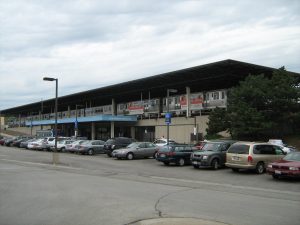Blue Line extension to 1st Avenue dying on the vine
By Bill Dwyer For Chronicle Media — July 18, 2016
The Forest Park terminus, which is connected to nine PACE bus routes, is the second busiest station of the 12 stations on the western end of the Blue Line. (Chronicle Media photo)
A proposed extension of the CTA’s Blue Line rapid transit service from its present terminus in Forest Park west to 1st Avenue in Maywood now looks unlikely to happen anytime soon.
Urban planner Rick Kuner, a former Oak Park village trustee and co-founder of the Citizens for Appropriate Transportation (CAT), has long pushed IDOT to include a number of rapid rail elements into any I-290 reconstruction plans, arguing that public transit options help reduce vehicle loads on the expressway and bring economic opportunity to communities served.
“The CTA has said they’re not going to do it,” Kuner said of the Blue Line extensison during a question and answer session before the Oak Park Village Board on July 11.
“It’s not that there are technical problems, it’s not a priority, and there’s not the political will and funding to do it.”
The CTA has been laying preliminary plans to reconstruct its Blue LIne rail system from downtown Chicago to its terminus in Forest Park at Des Plaines Avenue.
The Forest Park terminus, which is connected to nine PACE bus routes, is the second busiest station of the 12 stations on the western end of the Blue Line. The 1.16 million total rider entries represent 12 percent of that line segment’s ridership.
Ways to extend the Blue Line farther west have been discussed in various forums for the past decade. Former Oak Park Village President David Pope, who stepped down in 2014, was long a Blue Line extension proponent.
Asked who in area government is still advocating for the extension, Kuner said, “I don’t know that anyone is.”
While the CTA’s Blue Line Study Area states its intent is to “identify short and long term service strategies” for the line, and a Blue Line Study Map shows the boundaries extending from Canal Street in Chicago to Mannheim Road in Hillside, there are no plans for work beyond the existing Blue Line terminus in Forest Park.
Kuner said he believes a key reason the Blue Line extension is off the table is due in part to a lack of support by Chicago Mayor Rahm Emanuel,
“Rahm’s priorities for Chicago do not include extending the Forest Park branch of Blue Line,” Kuner opined. “CTA ridership on the O’Hare branch of the Blue Line is about 2.5 times greater than on the Forest Park branch. Extending the Dan Ryan branch of the Red Line further south is a higher priority for Chicago.
Pete Harmet, who heads IDOT’s I-290 expansion management team overseeing planning for the multi-billion dollar reconstruction of 13 miles of the Eisenhower Expressway, said that while the Blue Line extension is not currently a priority, it isn’t a dead issue.
“What we’ve seen, really, the driving issue is the lack of support of land use that would drive ridership for (an extension),” Harmet said, adding, “But let’s keep the possibility open.”
“IDOT and CTA have been working together in this process,” Harmet said, referring what termed the Phase one construction planning process. “That conversation continues.”
Any transit service between 1st Avenue and the Forest Park terminal, which is currently fed by nine PACE bus routes, will be more buses, Harmet said.
“The initial service, instead of heavy rail, will be more express bus,” Harmet said. “So we are thinking about those things, and not saying let’s drop the whole idea until heavy rail comes along.”
In 2008 officials of the Cook-DuPage Corridor Study presented preliminary plans for a major expansion of rapid rail and bus service in the western suburbs to the Regional Transportation Authority. That plan would include extension of the CTA Blue Line from Forest Park to as far west as Oak Brook, and the development of three north-south rapid rail and express bus transit corridors in Chicago, western Cook County and DuPage County.
However, the third and final phase of that Corridor Study was never done due to a lack of funding.
Kuner says that both IDOT and the CTA are not looking at building a rail extension to Maywood because “in essence, there’s no (population) density to support it.”
But Kuner disputes that, saying, “Every community in the Eisenhower corridor, with the exception of Hillside, has enough density for (rapid rail) traffic.” He added, “the density can be either population density or destination density.”
“Destination density” includes the Maybrook Courthouse near 1st Avenue and the Eisenhower, and the Loyola Medical Center, Hines VA Hospital and the Proviso Math and Science Academy, all a short bus ride to the south at 1st and Roosevelt Road.
Both the CTA and IDOT are winding down planning processes within the next year that will produce preliminary plans for how to proceed with actual construction.
IDOT expects to have a draft Environmental Impact Study ready for public review and comment by summer of 2017. The CTA intends to complete its Blue Line Visioning Study by the end of this year.
Kuner said people interested in keeping the extension idea alive should contact Illinois’ two U.S. senators, Richard Durbin and Mark Kirk, 7th District Congressman Danny Davis, State Senator Kimberly Lightford and State Rep. Chris Welch.
He said he expects a Blue Line extension to be built eventually, simply because it’s such a good, workable idea. But he wouldn’t hazard a guess as to when that might occur.
“It may not happen in my lifetime, but it will happen.”
Read the current issue of the Cook County Chronicle
Free digital subscription to the Cook County Chronicle
—
Blue Line extension to 1st Avenue dying on the vine —



